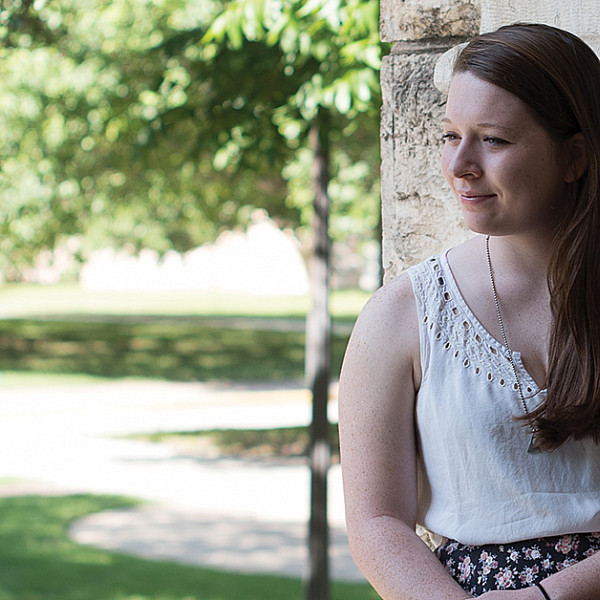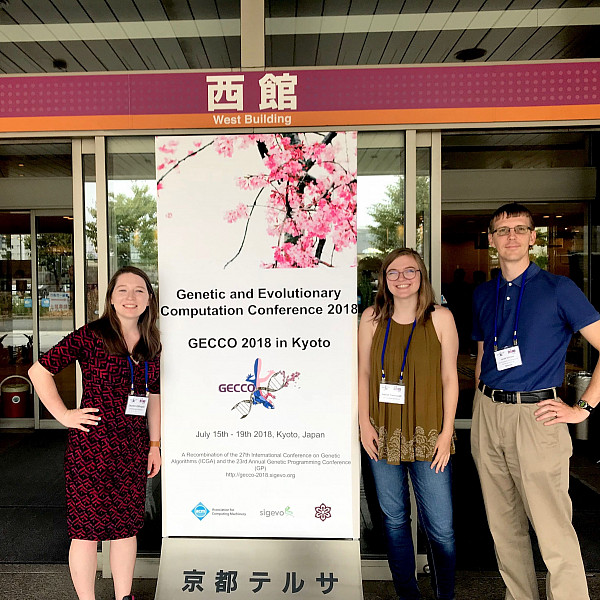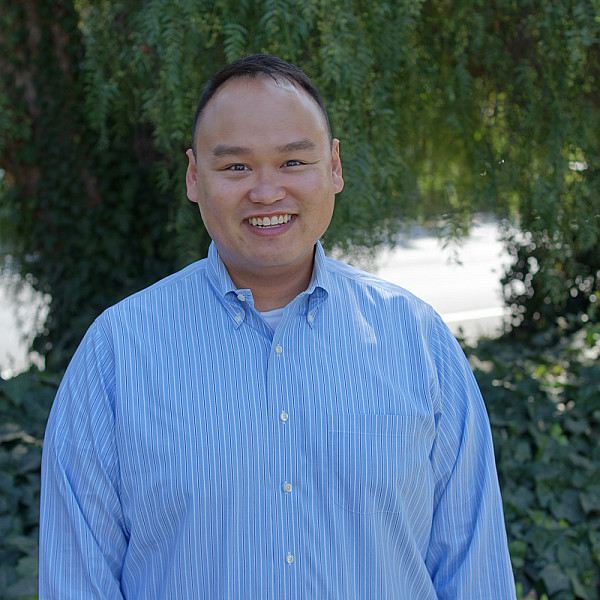News
Generating Art
February 04, 2021
February 04, 2021
Open gallery

Sarah Friday ’20, who prefers they/them/their as their pronouns, has been an artist since they were a child growing up in Midland, Texas. But during their senior year in high school, they ended up taking a computer science course that, they recall, “changed everything.” When they arrived at Southwestern, they knew they wanted to do something with both computer science and art. “But,” they add, “I didn’t really know if I would connect them at all; they were sort of separate.”
During their years at SU, Friday’s official focus as an art major was painting, and they specialize in conceptual art, meaning work in which the idea behind each piece is valued more than the techniques, the materials, or the aesthetics of the completed object. A sculpture class turned them onto ceramics as well. “Wheel-Forming was definitely a really, really good class. I made a lot of objects, like cups and stuff, and now I have a bunch of cups. I kind of have too many, but that’s OK,” they laugh. As a computer science major, their favorite course was Computer Organization, which Friday describes as providing an overview of the basic underlying elements of a computer, such as how registers, circuits, and the assembly code are arranged and interconnect.
Unlike art and computer classes in high school, they discovered, Southwestern courses required a great deal of independence. “You have to read a lot on your own, and you have to make these self-epiphanies. You’re more in charge of your learning. You’re guided, but it’s not as spoon-fed,” they share.
Synthesizing art and AI
Majoring in two intensive fields is “definitely a big commitment,” Friday advises, “so you have to decide that you’re really going to do both.” When they would tell people they were double majoring in studio art and computer science, the usual response was, “Oh, you’re going to do computer graphics then?” or “So you’re going to do something with comic books?” However, they explain, “I just use one or the other as tools for the other instead… . People automatically think you’re going to be completely intertwining [STEM and art], but you don’t have to. You don’t have to be torn between them, and you also don’t have to mix them if you don’t want to. I wasn’t going to mix them at all, but I ended up doing it in a more natural way for me.”
Their two fields of study have coalesced in a few ways. Much of Friday’s current artwork conceptually involves the Internet and social media, asking us to consider how we represent ourselves on social media and whether that identity is genuine or a mere shadow of—or in complete opposition to—our authentic selves. The way that computer science informs their artwork was also apparent in their senior exhibition for Southwestern this past fall: in the fascinating and inspired Doomscroll, Friday used colored pencils to illustrate circuit boards on an astonishing 261 inches (that’s nearly 22 feet) of paper, which imitates the way that many of us have engaged with technology during the pandemic, such as obsessively scrolling through news, social media, and other content on a screen.
But perhaps Friday’s most intensive synthesis of art and computer science came in the form of a yearlong research project. It incubated in the spring of 2019 as the 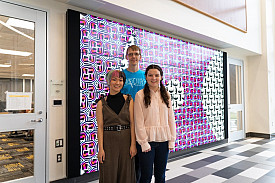
Credit: Carlos Barronterm project for an Artificial Intelligence elective course; Friday was then collaborating with computer science and English major Anna Krolikowski ’20 and computer science major Alice Quintanilla ’20. Friday and Krolikowski developed that research further, and in spring 2020, their project culminated in a presentation at an international conference as well as a peer-reviewed publication coauthored with Quintanilla and Associate Professor of Math and Computer Science Jacob Schrum ’06.
The project’s title, “Quantum Zentanglement,” is a play on the physics concept quantum entanglement, in which particles are close enough together or interact in such a way that one particle’s quantum state cannot be described separately from that of the other particle(s). Zentangles® are simple drawings in which the illustrator doodles patterns of shapes, lines, and curves within a square piece of paper as a form of meditation. While brainstorming a final project for the Artificial Intelligence course, Friday caught sight of a Zentangle created by Schrum’s wife that the professor had framed and hung on his office wall. Familiar with the popular drawings from middle and high school, Friday wondered aloud whether they and their partners could potentially use two forms of artificial intelligence to generate Zentangles: neural networks (i.e., algorithms that produce outputs from inputs, much like the neurons of the human brain might emit a response to food such as salty or return the word dog given an image of a dog) and wave function collapse (i.e., an algorithm, based on a concept from quantum physics, that can be used to generate or arrange uniform geometric tiled patterns according to certain constraints).
Interpreting old code and figuring out what it was doing was one challenge, Friday reveals. To better understand some of the unfamiliar mathematical underpinnings of their research, they enlisted the help of Fumiko Futamura, Lord chair and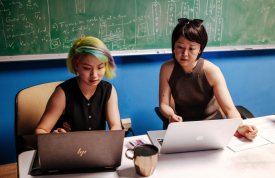
Credit: Carlos Barron
professor of mathematics and computer science (with whom Friday would embark on a separate yearlong research project, this time creating a new technique for the age-old problem of multiplying matrices, through the Summer Collaborative Opportunities and Experiences, or SCOPE, program). Schrum had also encouraged Friday and Krolikowski to turn their findings into a presentation as well as a publication, to which he contributed. Their paper, “Quantum Zentanglement: Combining Picbreeder and Wave Function Collapse to Create Zentangles®,” was accepted by the coordinators of EvoMUSART, an international conference on artificial intelligence in music, sound, art, and design, which was scheduled to take place in Seville, Spain, in April 2020.
Unfortunately, COVID-19 prevented Schrum, Friday, and Krolikowski from attending in person—a significant disappointment for Friday, who had not previously had the opportunity to travel abroad. However, despite some inconvenient differences in time zones, they were able to attend at least some of the panels and present their work. Thanks to some professional networking orchestrated by Schrum, they enjoyed being mentored by Anikó Ekárt, a scholar of software engineering and computational intelligence who was helping to convene the conference. Friday also appreciated the questions and positive feedback their project garnered from experts in the field. Their article was soon published in the conference proceedings, and having recorded a version of their presentation just in case anything went wrong with their livestream (it didn’t, luckily), Friday and Krolikowski were able to share their work as part of Southwestern’s virtual Research and Creative Works Symposium in April as well.
Presenting original research and having a publication under their belt before graduating from college are undoubtedly sources of pride for Friday, but the most fun part of the “Quantum Zentanglement” project, they say, was becoming an expert in wave function collapse. Another favorite component of their research was getting to think about and discuss broader philosophical questions, such as “if a computer makes something, is that considered art?” Friday’s own insights into that big question might surprise those who think that art is the domain of only human beings. “Some artists don’t consider computers to be capable of creativity, but I think it definitely depends,” they explain. “A lot of times, there’s human interaction, so the humans are guiding the computer and utilizing the computer’s expressive power, but in that instance, the computer is not an autonomous agent. But for things like Google Deep Dream and AICAN [an artificial-intelligence artist created by Rutgers University computer science professor Ahmed Elgammal], where they let the computer generate these pictures with little human input in the actual image-making process, I think that could be considered creativity and true computer art compared to what should really be called digital art.”
That kind of thought-provoking analysis is a testament to the recent graduate’s enviable facility with making original connections: grappling with significant conceptual questions such as how we define creativity, understanding the opportunities made possible in collaborations between humans and technology, and illustrating links between the seemingly unrelated disciplines of art, science, and philosophy.
Doing the work—with intentionality
As it did for most any other college senior, the spring and fall semesters of 2020 proved difficult for Friday: although their classes in computer science transitioned online fairly easily, completing their final semester remotely meant they “missed the energy of being on campus” and “all of the graduation traditions” that give a senior closure on their university experience. They also missed the SU Fine Arts Center’s excellent studios. Still, Friday was able to adapt. “Art’s function is to fingerprint culture and history, so it is highly important that art is being made during these times. However, there are not many artists who can financially afford to be doing art,” they explain. “Personally, I was able to continue with my art practice because I switched to drawing, which is a less resource-intensive discipline, especially compared to painting or ceramics. I mostly used materials I already had. It was both therapeutic and productive to do my art capstone, so I actually enjoyed it.”
“Art’s function is to fingerprint culture and history, so it is highly important that art is being made during these times.”
Friday has applied to Ph.D. programs in computer science and looks forward to learning even more about artificial intelligence and computer organization in coming years. “Doing SCOPE and this research project with Dr. Schrum has shown me that I actually like research. Before, I really thought research was just reading books and writing about what you read in books. That’s a little part of it, but it’s just the literature review part. It’s a much broader thing. You get to be a lot more hands on,” they share. After completing their doctorate, Friday may pursue a master’s in art, a career in academia, or research in industry—tech and other companies such as Uber, Google, and (infamously) Facebook, for example, have all contributed to major steps forward in artificial intelligence and other computer research.
To younger students who might follow a similar path, or paths, as it were, Friday says that computer science is “really not as difficult as it sounds—as long as you do your work,” they add with a laugh. “A lot of it you learn through examples and through working it out, so if you don’t do your work, then you might not be as successful.” For those who seek to major in art, the recent grad divulges that mental and emotional preparation are in order. “The academic world of art is very different from high school and sometimes considered pretentious, so that’s something to look out for to make sure you’re ready for that direction,” they explain. In conceptual art, they continue, the goal “has shifted from making beautiful images to making images that pose questions and are very conceptually or intellectually rigorous, so a lot of times, certain arts get devalued.” One argument, for example, concerns whether ceramics constitute an art or a craft. “And if you’re not ready to justify what you’re doing as being art as opposed to craft, then you might get your feelings hurt a lot by critiques or even just reading about things because you might internalize it and think, ‘Oh, then I’m not an artist. I’m not doing art; I’m doing crafts.’ So,” they suggest, “you’re going to have to think more about your intentions in the pieces that you make.”
“Lasting impressions”
Friday says that they appreciate the academic experiences and achievements they’ve had at Southwestern as well as the theoretical and practical preparation for professional life that the university has provided. But, they add, “the social connections—not just between peers but also with faculty—have definitely made the biggest impact on my career as a college student.” They treasure having found such supportive friends, including fellow Schrum student and Picbreeder expert Lauren Gillespie ’19. They express special fondness for their SCOPE supervisor: Futamura, who is something of a kindred spirit in that she is also a successful artist in addition to her scholarly accolades, is “so kind, always welcoming, and very relatable and personable,” Friday says affectionately. Professor of Computer Science Barbara Anthony has been another beloved mentor, offering advice on the courses they should take. They are obviously grateful for Schrum, too, because he helped with their recent research. However, Friday also appreciates their professor and coauthor for having been there since day one on campus. “He was actually the person I talked to when I came in for orientation,” they recall. “So that’s really cool to get to work with him so closely after just meeting him at Sprog Day.”
Friday will happily keep in touch with their mentors and friends through Slack, which computer science faculty, students, and alumni use to post announcements. It’s just another way that community members maintain those personal connections that distinguish the SU experience and create, says Friday, “the lasting impressions that I have from Southwestern.”
















